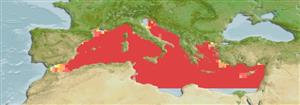Actinopterygii (ray-finned fishes) >
Perciformes (Perch-likes) >
Istiophoridae (Billfishes)
Etymology: Tetrapturus: Greek, tetra = four + Greek, pteron, fin, wing (Ref. 45335). More on author: Rafinesque.
Environment / Climate / Range
Ecology
Marine; pelagic-oceanic; oceanodromous (Ref. 51243); depth range 0 - 200 m (Ref. 43). Deep-water, preferred ?; 46°N - 32°N, 6°W - 36°E (Ref. 43)
Mediterranean Sea: considerably abundant around Italy. No confirmed report from the Black Sea. No adults have been reported east of the Ionian Sea. Highly migratory species, Annex I of the 1982 Convention on the Law of the Sea (Ref. 26139). Reportedly caught from the Aegean Sea (Pennetti, pers. comm.).
Size / Weight / Age
Maturity: Lm ? range ? - ? cm
Max length : 240 cm TL male/unsexed; (Ref. 4770); common length : 200 cm OT male/unsexed; (Ref. 43); max. published weight: 70.0 kg (Ref. 43)
This species is the most common istiophorid in the central basin of the Mediterranean and completes its life cycle inside this sea as far as is known to date. Probably swims in the upper 200 m water layer, generally above or within the thermocline. Travels in pairs, possibly corresponding to a feeding behavior. Feeds on fishes. Probably more widespread in the Mediterranean Sea and may have been identified as T. albidus by anglers and fishermen.
Life cycle and mating behavior
Maturity | Reproduction | Spawning | Eggs | Fecundity | Larvae
Winter and spring might not be an unreasonable hypothesis for the spawning season of this species.
Nakamura, I., 1985. FAO species catalogue. Vol. 5. Billfishes of the world. An annotated and illustrated catalogue of marlins, sailfishes, spearfishes and swordfishes known to date. FAO Fish. Synop. 125(5):65p. Rome: FAO. (Ref. 43)
IUCN Red List Status (Ref. 115185)
CITES (Ref. 94142)
Not Evaluated
Threat to humans
Harmless
Human uses
Fisheries: minor commercial
More information
ReferencesAquacultureAquaculture profileStrainsGeneticsAllele frequenciesHeritabilityDiseasesProcessingMass conversion
Tools
Can't connect to MySQL database fbquizv2. Errorcode: Too many connections
